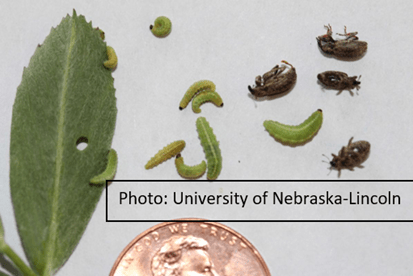2023 Weevil Watch
BY Dairyland Seed Agronomy Team
The weather should be clear for many of us this week, with prime conditions for planting corn and soybeans ahead. For alfalfa producers, don’t forget about monitoring the mighty weevil. Many areas will see it show up before corn emerges from the ground.
Alfalfa weevil egg hatch begins when 300 GDUs have accumulated. Some universities note that larvae can show up as soon as 200 GDUs, but this may be more of the exception. During April, northern Indiana and Illinois accumulated 200-225 GDUs; Michigan, Wisconsin, southern Minnesota, and South Dakota accumulated 100-200 GDUs; and North Dakota, northern Minnesota, far northern Wisconsin, and the Upper Peninsula are all sub-100 accumulated GDUs. We will reach the hatch quickly, no matter your geography. By the time we reach 440-450 GDUs, the larvae will be in the 3rd instar, which is when heavy feeding begins.

Scouting
Get out in front of this pest as you pass 300 GDUs, watching for feeding through second crop. Rarely do issues show up in third or fourth crop. The pale-green larvae have black heads and tend to feed on the young growth at the top of the plants. Adults, found after 800 GDUs, are gray beetles with small snouts.

Control
The University of Wisconsin recommends control when 40 percent of first crop plants show signs of feeding. Do not confuse this with 40 percent defoliation! If 40 percent of the plants are experiencing feeding, and harvest is more than 10 days out, consider spraying an insecticide to manage the weevils. If the normal cutting schedule puts harvest at less than 10 days, go cut immediately. Early harvest will save an insecticide application. Especially with the early harvest strategy, watch 2nd crop regrowth carefully for continued feeding. If weevils are present and regrowth does not start 3 to 4 days after cutting, spray with an insecticide immediately.
For more details, North Dakota State University published the excellent Integrated Pest Management of Alfalfa Weevil in North Dakota. The publication reminds us that sweep nets are very useful for weevil detection, but that stem counts are best for determining action thresholds. To aid your decisions, they model economic scenarios based on the growth stage of the alfalfa, the number of larvae per stem, the value of the alfalfa and the cost of control.

Brian Weller
Western Region
507.456.3034

Rod Moran
Western Region
507.456.3034

Dan Ritter
Central Region
219.863.0583

Branden Furseth
Northern Region
608.513.4265

Mark Gibson
Eastern Region
260.330.8968

Amanda Goffnett
Eastern Region
989.400.3793

Ryan Mueller
Eastern Region
989.400.3793
